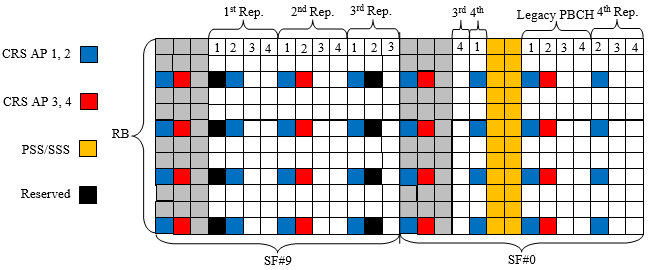|
4G/LTE - BL/CE |
||
|
LTE-BL/CE (LTE-M1) - PBCH
Based on 36.331 5.2.1.2 Scheduling, MIB scheduling is described as below :
The MIB uses a fixed schedule with a periodicity of 40 ms and repetitions made within 40 ms. The first transmission of the MIB is scheduled in subframe #0 of radio frames for which the SFN mod 4 = 0, and repetitions are scheduled in subframe #0 of all other radio frames. For TDD/FDD system with a bandwidth larger than 1.4 MHz that supports BL UEs or UEs in CE, MIB transmission may be repeated in subframe#9 of the previous radio frame for FDD and subframe #5 of the same radio frame for TDD.
This implies that in BL/CE FDD case, a new MIB is transmitted over two subframe (subframe #9 and #0) every 40 ms. But MIB is retransmitted at every subframe where SFN mod 4 is not 0. Therefore, if you see the MIB transmission on spectrum analyzer, you would see the MIB transmission over two subframe at every 10 ms as you see in Example : MIB/SIB1/SIB2 on Spectrum Analyzer
Followings description is from R1-156751. (I don't think I need to put my own comments here since the description in the TDoc is already clear / obvious)
For FDD, in order to optimize coherent combining of repetitions due to the (uncorrected) frequency offset, the subframes with PBCH repetitions are #9 and #0. Figure 1 presents a mapping for PBCH repetitions. a) 3 symbols per subframe are used for the legacy control region and, after excluding symbols for PSS/SSS, there are a total of 20 symbols for PBCH repetitions (including the legacy one), thereby allowing for an integer number of 5 repetitions (including the legacy one). b) Symbols labeled ‘1’, ‘2’, ‘3’, and ‘4’ contain respectively the REs for the 1st, 2nd, 3rd, and 4th symbol of the legacy PBCH transmission.
< R1-156751 Figure 1: Mapping for PBCH repetitions in FDD to enable increased SINR for frequency error correction.>
Reference :
[1] 3GPP R1-156751 3GPP TSG RAN WG1 #83 - Mapping for PBCH Repetitions
|
||
